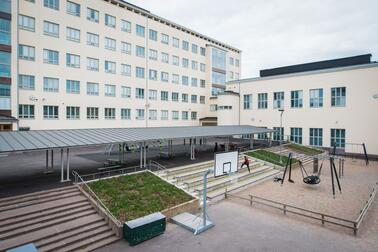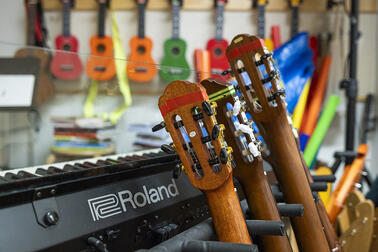
What is ‘luuydin’ in English? Questions such as this are tackled during English teacher Sergei Saikkinen’s lesson at Malmi Comprehensive School in Helsinki. Saikkinen is giving an English lesson to the bilingual 7K class. The lesson is primarily in English, but the pupils are taught key terms in both languages. In addition to the English equivalent of ‘luuydin’ (bone marrow), the seventh graders are able to effortlessly translate words such as ‘kantasolu’ (stem cell). Saikkinen loves his job as a bilingual class teacher.
“Language skills are a key that opens doors to many different cultures and views. By developing your language skills, you open yourself to the world.”

Language tests in the spring
Malmi Comprehensive School provides bilingual Finnish–English education in grades 1–9. At least 25% of the teaching is provided in English. Pupils are admitted from all over Helsinki and selected for the group with a language test in the spring.
The City of Helsinki provides bilingual basic education in English, Spanish, Chinese, Northern Sámi, Russian and Estonian. Pupils can start attending bilingual education from first grade at primary school or seventh grade at lower secondary school. Those who want to switch to bilingual education in lower secondary school are required to have adequate language skills to begin with. A pupil who moves to Helsinki and has previously attended bilingual basic education can apply to all comprehensive school classes through continuous admission.
In bilingual education, the other language is always Finnish. 25–50% of the education is provided in the foreign language, in accordance with the curriculum determined by the school.
Bilingual education develops the pupil’s listening comprehension, reading and writing skills in the target language, as well as their oral language skills. The education also promotes international-mindedness and develops pupils’ ability to study other languages as well.
Everyday language skills
Another bilingual class at Malmi Comprehensive School is taught by Elena Ståhle, who is the teacher of class 5-6K. Her class features six fifth-graders and 14 sixth-graders. Some lessons are held jointly, others separately.
In practice, bilingual education means using Finnish and English side by side.
“The aim is to strengthen the pupils’ skills in both languages. Learning always starts from good mother tongue skills. The better you are at your mother tongue, the better you are able to learn in a foreign language,” Ståhle explains.
The teaching utilises the CLIL method, which stands for Content and Language Integrated Learning.
“This method combines the learning of language with other subjects. For example, it can mean talking about the topics of a biology lesson in English during an English lesson,” Saikkinen says.
Ståhle and Saikkinen encourage pupils to apply to a bilingual class if they have any interest in improving their language skills. “No prior experience with bilingual education is necessary.”

For a wide variety of learners
The teachers’ view is that a bilingual class is suited for everyone interested in developing their language skills and enthusiastic about internationality. No prior experience with bilingual studies is required. “The most important thing in learning languages is your own motivation. Pupils attending a bilingual class may have to work a little harder at first, as we study the contents of the same curriculum in two languages,” Ståhle comments.
Ståhle’s class features a wide variety of learners. Some of them speak English at home, while others have no prior experience with bilingualism. “I see having pupils with different levels of English skills in the same group as enriching. They learn from one another in everyday activities.”
Saikkinen feels that language skills serve as capital that cannot be bought. Language skills open doors into the future and the internationalising world.
“When I was young, my mother encouraged me to study languages. She wisely said that when I grow up, I won’t have to carry dictionaries in my backpack, as the words will be carrying me instead.”

A close-knit community
Seventh-graders Riiko, 13, Jon, 13, and Turkina, 12, attend a bilingual class at Malmi Comprehensive School. They are currently studying subjects such as home economics, music and P.E. in English. In mathematics, they learn the key terminology in both languages. There are sixteen pupils in the class.
“We quickly grew into a close-knit community. It feels like we’ve been together for years, even though we’ve only known each other since seventh grade,” Turkina comments.
All are happy with their choice of attending the bilingual class. “It will be easier to find work in the future when you have good language skills,” Riiko muses.
The seventh-graders encourage anyone with any interest in language skills and internationality to apply to a bilingual class. “Some hesitate to speak English because they feel that they are speaking so-called race car driver English. Your accent makes no difference. We’re all still learning,” Turkina says before heading out for a break.
Text: Eveliina Lauhio



